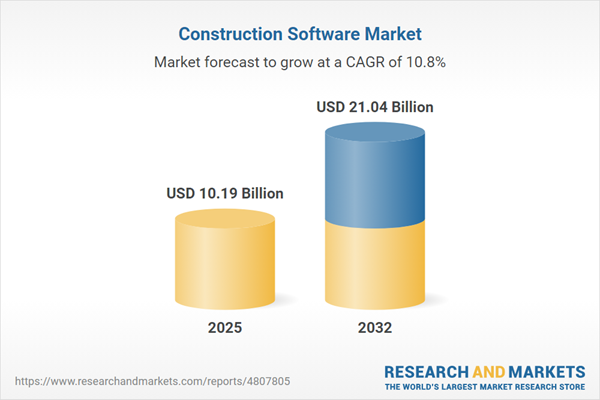Speak directly to the analyst to clarify any post sales queries you may have.
In a rapidly evolving built environment, construction software is reshaping how projects are delivered, integrating innovation with operational efficiency and stakeholder demands. For senior decision-makers, staying ahead in this dynamic market requires a clear understanding of the latest technology advances, regulatory drivers, and regional nuances.
Market Snapshot: Construction Software Market Size and Growth
The construction software market grew from USD 9.25 billion in 2024 to USD 10.19 billion in 2025. It is projected to continue expanding at a CAGR of 10.81%, reaching USD 21.04 billion by 2032. This robust trajectory underscores strong demand for digital transformation across project delivery chains, as organizations aim to drive cost control, accelerate timelines, and navigate increasing complexity.
Scope & Segmentation
This report provides a granular view of the construction software sector, examining technology trends and adoption patterns across diverse segments, deployment models, applications, user categories, and key regions.
- Software Types: Accounting Software, Bidding Software, Building Information Modeling (BIM), Construction Management Software, Design Software, Field Service Management, Safety & Reporting.
- Key Features Covered: Budget Tracking, Expense Reporting, Invoicing Software, Cost Estimation, Document Management, Project Scheduling, Resource Management, 2D Design Applications, 3D Modeling Software, Equipment Management, Time Tracking.
- Deployment Models: Cloud-Based, On-Premises.
- Applications: Commercial Construction, Industrial Construction, Infrastructure Construction, Residential Construction.
- End-Users: Builders & Contractors, Consultants, Engineers & Architects.
- Geographic Coverage: Americas (United States, Canada, Mexico, Brazil, Argentina, Chile, Colombia, Peru), Europe (United Kingdom, Germany, France, Russia, Italy, Spain, Netherlands, Sweden, Poland, Switzerland), Middle East (United Arab Emirates, Saudi Arabia, Qatar, Turkey, Israel), Africa (South Africa, Nigeria, Egypt, Kenya), Asia-Pacific (China, India, Japan, Australia, South Korea, Indonesia, Thailand, Malaysia, Singapore, Taiwan).
- Company Profiles: Aconex by Oracle Corporation, Ampd Energy, Archdesk, Astral Technologies, Autodesk, Inc., Bluebeam, Inc., Branch Technology, Bridgit, Inc., Buildern, BuilderTek, LLC, Buildertrend Solutions, Inc., Buildxact, Clear Estimates, Inc.
Key Takeaways: Strategic Insights for Decision-Makers
- Integrated platforms are advancing cross-team collaboration, regulatory compliance, and project transparency in an increasingly digital construction landscape.
- Cloud and mobile technologies are enabling real-time data flow between job sites and back offices, resulting in fewer errors and enhanced schedule control.
- Artificial intelligence and analytics are transforming project planning, resource allocation, and risk management with predictive capabilities.
- Regulatory and sustainability trends are driving demand for built-in compliance, carbon tracking, and emissions reporting features within construction software solutions.
- Regional adoption patterns vary: The Americas lead in digital transformation, EMEA drives regulatory innovation, and Asia-Pacific is experiencing rapid uptake linked to urbanization and infrastructure investment.
- Segment-specific requirements have spurred specialization, from asset lifecycle management for industrial contractors to intuitive interfaces for residential builders.
Tariff Impact: Navigating the Shifting US Trade Environment
Upcoming United States tariffs in 2025 are expected to influence procurement strategies and cost structures. Hardware components essential for running advanced construction software—such as servers, tablets, and IoT sensors—could face price increases, affecting cost-of-ownership models. Service providers with overseas data centers may adjust subscription fees or support models in response, prompting procurement teams to explore flexible contracts, hybrid deployment, and localized hosting solutions to stabilize budgets.
Methodology & Data Sources
This report utilizes a robust, multi-stage research process combining primary interviews with construction executives, project managers, software vendors, and channel partners, alongside secondary review of regulatory filings, technical literature, and case studies. Data triangulation and expert validation ensure rigor and accuracy throughout the analysis.
Why This Report Matters
- Enables technology leadership to make informed purchasing and deployment decisions aligned with strategic objectives.
- Equips procurement, IT, and executive teams with validated trends, emerging risks, and actionable frameworks for optimizing software portfolios.
- Positions organizations to benchmark against industry leaders and rapidly adapt to regulatory or geopolitical change.
Conclusion
Digital construction software is a critical lever for efficiency, risk control, and sustainability. Investing in future-ready platforms and resilient procurement strategies empowers organizations to remain competitive as the sector transforms.
Additional Product Information:
- Purchase of this report includes 1 year online access with quarterly updates.
- This report can be updated on request. Please contact our Customer Experience team using the Ask a Question widget on our website.
Table of Contents
3. Executive Summary
4. Market Overview
7. Cumulative Impact of Artificial Intelligence 2025
Companies Mentioned
The companies profiled in this Construction Software market report include:- Aconex by Oracle Corporation
- Ampd Energy
- Archdesk
- Astral Technologies
- Autodesk, Inc.
- Bluebeam, Inc.
- Branch Technology
- Bridgit, Inc.
- Buildern
- BuilderTek, LLC
- Buildertrend Solutions, Inc.
- Buildxact
- Clear Estimates, Inc.
Table Information
| Report Attribute | Details |
|---|---|
| No. of Pages | 198 |
| Published | November 2025 |
| Forecast Period | 2025 - 2032 |
| Estimated Market Value ( USD | $ 10.19 Billion |
| Forecasted Market Value ( USD | $ 21.04 Billion |
| Compound Annual Growth Rate | 10.8% |
| Regions Covered | Global |
| No. of Companies Mentioned | 14 |









